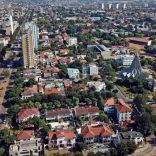Mozambique: Ireland to invest €5.4M in Niassa social infrastructure
Mozambique will only grow 2% this year – read the full World Bank report

in file CoM
The World Bank has revised expected GDP growth for Mozambique downwards by 1.5 percentage points from the 3.5% growth forecast in January.
Read the full World Bank Flagship Report ‘Global Economi Prospects – Heightened Tensions, Subdued Investment’ HERE, in English.
“Southern and East Africa was hit by two devastating cyclones in March and April 2019, which took a heavy human toll and severely affected economic activity in the Comoros, Malawi, Zimbabwe, and in particular, Mozambique,” analysts write in a flagship report on ‘Global Economic Prospects’.
In the document released on Tuesday in Washington, experts from the multilateral financial institution cut Mozambique’s expected economic growth from the 3.5% forecast in January to 2% this year, and from 4.1% to 3.5% in 2020.
“Current account deficits have widened across the region, partly reflecting weaker exports (Guinea, The Gambia), and sizeable capital goods imports related to large investment projects (Côte d’Ivoire, Mozambique, Niger),” the document declares. In the case of Mozambique, “the deficit will increase further during cyclone effects due to weakened exports of agricultural materials and high imports of reconstruction and relief supplies”.
The pressure of the October elections, they add, does not help the country’s financial position, which, like other countries, is in financial difficulties which could increase due to various developments. “Countries holding elections during the next two-and-a-half years together account for one quarter of the region’s GDP, and the risk of fiscal slippages is particularly high, as domestic political considerations could undermine fiscal consolidation efforts”.
ALSO READ: World Bank warns of weaker global growth
“First, although external financing conditions have recently have recently become more benign, they could tighten again if investor sentiment were to deteriorate,” the World Bank writes, adding that “this could pose a significant risk to the outlook for countries with elevated debt burdens or where a large share of debt is denominated in foreign currency. Higher interest rates and weaker currencies would increase the cost of servicing debt and refinancing would absorb revenues and limit spending to reduce poverty”.
Secondly, “state-owned enterprises in some countries (Angola, Ethiopia, Ghana, Mozambique, South Africa), particularly in the energy sector, have sizeable debts that pose an additional contingent liability risk to already indebted governments”.
In the report, World Bank economists cut sub-Saharan Africa’s growth forecast to 2.9% this year, highlighting concerns about rising public debt, slowdown in major partners and funding difficulties.
“The recovery in sub-Saharan Africa has disappointed, with weakening external demand, supply disruptions, and elevated policy uncertainty weighing on activity in major economies,” the report reads, which puts growth forecast at 2.9% for this year, down from the forecast of 3.4% in January.
In this ‘Global Economic Prospects’ report, World Bank economists anticipate 3.3% growth in sub-Saharan Africa next year, “assuming that investor sentiment will improve in some of the large economies in the region, that oil production in large oil exporters will recover, and that robust growth in non-resource-intensive economies will be underpinned by continued strong agricultural production and sustained public investment”.












Leave a Reply
Be the First to Comment!
You must be logged in to post a comment.
You must be logged in to post a comment.